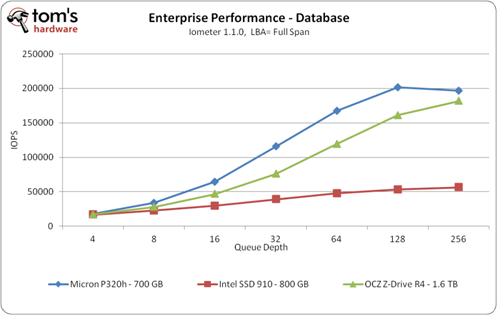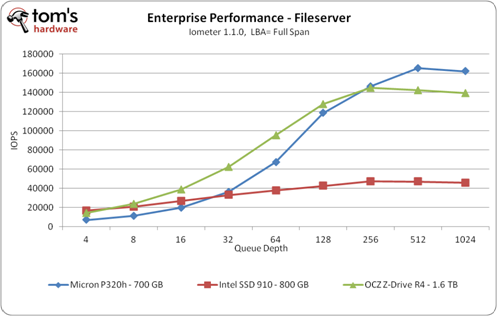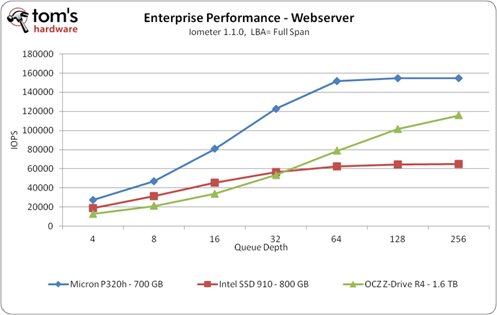Micron RealSSD P320h Review: A PCIe Drive Capable Of 3.2 GB/s
Announced earlier this year, Micron's RealSSD P320h PCI Express-based SSD promises to be an enterprise workhorse. A custom controller, single-level cell NAND, amazingly low latency, stellar random I/O, and incredible endurance combine to blow us away.
Enterprise Workload Performance
The next set of tests simulates different enterprise workloads, including database, file server, Web server, and workstation configurations.
Our Iometer database workload (also categorized as transaction processing) involves purely random I/O. Its profile consists of 67% reads and 33% writes using 8 KB transfers.
The P320h maintains a steady lead over OCZ's Z-Drive R4 across all queue depths. This should come as no surprise given what we saw on the previous page, and considering that this workload is more heavily weighted towards reads.
The file server workload consists of 80% random reads of varying transfer sizes. Because the P320h has an advantage over OCZ's Z-Drive R4 in random reads, we thought these results would look a lot more like the database chart. To our surprise, though, the Z-Drive R4 holds its own against the P320h, edging it out at almost all queue depths.
Originally, we left off at a queue depth of 256. But after reviewing the results, it looked like the P320h had a little bit left in its proverbial tank. So, we reran the numbers at queue depths of 512 and 1024, too. Under that extra load, the P320h finally came out on top.
The Web server (100% read, varying transfer size) and workstation (80% reads, 80% random) workloads don't provide nearly as much drama. The P320h easily tops the Z-Drive R4 and SSD 910 at all queue depths.
Get Tom's Hardware's best news and in-depth reviews, straight to your inbox.
Current page: Enterprise Workload Performance
Prev Page 4 KB Random Performance Next Page Sequential Performance-
mayankleoboy1 i dont see this as the future of consumer SSD's, just like a 16 core CPU is not the future of consumer CPU's.Reply -
bawchicawawa mayankleoboy1i dont see this as the future of consumer SSD's, just like a 16 core CPU is not the future of consumer CPU's.Reply
Such an apples to oranges comparison... -
memadmax Eliminating the SAS controller is the logical way to have these pci-e based ssd drives...Reply
Kinda surprised something like this didn't come out first as it makes more sense.... -
mayankleoboy1 bawchicawawaSuch an apples to oranges comparison...Reply
really ? Increasingly, performance is basically dependent on extracting parallelism. Whether in storage or in CPU performance.
Desktop/Mainstream users just dont do so much in parallel that they can fully use all the hardware. -
JOSHSKORN mayankleoboy1i dont see this as the future of consumer SSD's, just like a 16 core CPU is not the future of consumer CPU's.I see a purpose for 16 core processors. How are we going to otherwise be able to run Crysis 6?Reply -
mayankleoboy1 JOSHSKORNI see a purpose for 16 core processors. How are we going to otherwise be able to run Crysis 6?Reply
Use a 5000 core GPU ? -
youssef 2010 ArticleAlthough read performance is out of this world, the RealSSD P320h's write performance isn't nearly as spectacular. That's not to say the drive doesn't do well; it's just not as impressive after looking at those massive read numbers. read performance was out of this world, the write performance wasn't nearly as spectacular. Now, that's not to say that the P320h doesn't perform well, it's just not as impressive as the read resultsReply
????????!!!!!!!!!!! -
abbadon_34 After all these years it's nice to see the OCZ Revo at least mentioned. Considering a bootable PCI-E x4 SSD can be had for under $200 for over 5 years now, and is on it's 4th+ generation, one can only wonder why it's been ignored for so long.Reply -
Marcus52 Micron deserves a pat on the back for this one!Reply
Thanks for the review, love to see this kind of advancement and a peak into the future new hardware brings with it, even if it isn't directly applicable to me at this point in time.



